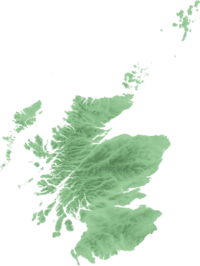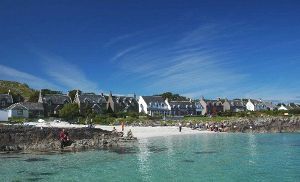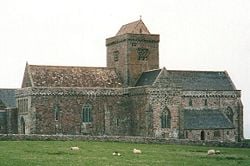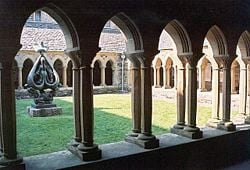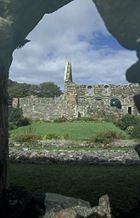Iona
| Iona | |
|---|---|
| Location | |
| Iona shown within Scotland. | |
| OS grid reference: | NM275245 |
| Names | |
| Gaelic name: | Ì Chaluim Cille |
| Norse name: | Eyin Helga; Hioe (hypothetical) |
| Meaning of name: | Gaelic for 'Columba's island'. |
| Area and Summit | |
| Area: | 877 ha (2,166 acres) |
| Area rank (Scottish islands): | 55 |
| Highest elevation: | Dùn Ì 101m (331 ft) |
| Population | |
| Population (2001): | 125 |
| Population rank (inhabited Scottish islands): | 40 out of 97 |
| Main settlement: | Baile Mór |
| Groupings | |
| Island Group: | Mull |
| Local Authority: | Argyll and Bute |
| References: | [1][2][3] |
Iona is a small island, in the Inner Hebrides, Scotland. Iona has an important place in the history of Christianity in Scotland and is popular for its tranquility and natural beauty. Its Gaelic name is Ì Chaluim Cille (Saint Columba's Island), or sometimes just Ì or Idhe.
Geography
Iona lies approximately one mile (1.6 km) from the coast of Isle of Mull. The island is 1 mile wide (1.6 km) and 3.5 miles (5.6 km) long with a resident population of 125.[4]
Iona's highest point is Dùn Ì (101 m, 331 ft), an Iron Age hill fort dating from 100B.C.E.-200C.E. Its geographical features include the Bay at the Back of the Ocean and Càrn Cùl ri Éirinn (the Hill with His Back to Ireland), said to be adjacent to the beach where St. Columba first landed.
History
In 563 C.E., Saint Columba, also known as Colm Cille, was exiled from his native Ireland as a result of his involvement in the Battle of Cul Dreimhne,[citation needed] and founded a monastery here with 12 companions. From Iona they set about the conversion of pagan Scotland and much of northern England to Christianity. Iona's fame as a place of learning and Christian mission spread throughout Europe and it became a major site of pilgrimage. Iona became a holy island where several kings of Scotland, Ireland and Norway came to be buried.
Many believe that the Book of Kells was produced, in whole or in part, on Iona towards the end of the 8th century. A series of Viking raids on the monastery on Iona began in 794, and after its treasures had been plundered many times, Columba’s relics were removed and divided two ways between Scotland and Ireland in 849 as the monastery was abandoned.[5] A convent for the Order of Benedictine Nuns was established in 1203, with Beathag, daughter of Somerled, as first prioress. The present Benedictine abbey was built in the same period. The monastery itself flourished until the Reformation when buildings were demolished and all but three of the 360 carved crosses destroyed.[6]
Iona Abbey
One of the oldest and most important religious centres in Western Europe, Iona Abbey is considered the point of origin for the spread of Christianity throughout Scotland.[citation needed]
Iona Abbey is located on the Isle of Iona, just off the Isle of Mull on the West Coast of Scotland. The abbey was founded by St. Columba after he had been linked to founding Oronsay Priory.
In 563 C.E., Saint Columba at Iona from Ireland. He founded a monastery on this site. The abbey grew quickly and soon became one of the largest religious centres in western Europe. Monks from Iona set up religious centres as far away as Switzerland.
The Book of Kells, a famous illuminated manuscript, was produced by the monks of Iona in the years leading up to 80.0 The Chronicle of Ireland was also produced at Iona until about 74.0
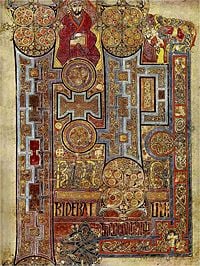
In 806 C.E., everyone at the abbey was found dead. This has been attributed to a Viking massacre. Three other Viking attacks are recorded within eleven years of this date.
The Celtic Church remained separate from the Roman Catholic Church for many centuries. However, by the 13th Century, Iona had been absorbed into the Roman Church. It became part of the Benedictine order. Another Benedictine foundation, the Iona Nunnery, was established nearby in 1203.
With the advent of the Protestant Reformation in Scotland, Iona along with numerous other abbeys throughout Scotland, England, Wales and Ireland were closed or destroyed. Many of Iona's buildings were demolished.
In the 19th Century, Iona was granted to the Church of Scotland, which undertook extensive restoration of the site. In 1938, the Reverend George MacLeod led a group which rebuilt the abbey, and founded the Iona Community. This ecumenical Christian community continues to use the site to this day.
The site was much loved by John Smith, Leader of the Labour Party. After his sudden death in 1994, he was buried on Iona.
Items of Interest
Many early Scottish kings and chiefs, as well as kings from Ireland, Norway and France are buried in the Abbey graveyard. (There are thought to be 48 kings there.) These include Duncan - the victim of Macbeth. The more recent grave of John Smith can also be seen.
Several Celtic Crosses are to be found on the Isle of Iona. St Martin's Cross (dated to the 8th Century) still stands by the road side. A replica of St John's Cross is found by the doorway of the Abbey. The restored original is located in the Infirmary Museum at the rear of the abbey.
The contemporary Jedburgh-based sculptor Christopher Hall worked for many years on carvings on the cloisters of the abbey, which represent birds, flora and fauna native to the island. More recently Hall was responsible for carving John Smith's gravestone.
Iona Abbey, now an ecumenical church, is of particular historical and religious interest to pilgrims and visitors alike. It is the most elaborate and best-preserved ecclesiastical building surviving from the Middle Ages in the Western Isles of Scotland. In front of the Abbey stands the 9th century St Martin's Cross, one of the best-preserved Celtic crosses in the British Isles, and a replica of the 8th century St John's Cross (original fragments in the Abbey museum).
The ancient burial ground, called the Reilig Odhráin, contains the 12th century chapel of St Odhrán (said to be Columba's uncle), restored at the same time as the Abbey itself. It contains a number of medieval grave monuments. The abbey graveyard contains the graves of many early Scotland/Monarchs|kings of Scotland, as well as kings from Ireland, Norway and France. Iona became the burial site for the kings of Dál Riata and their successors. Notable burials there include:
- King Kenneth I of Scotland
- King Donald II of Scotland
- King Malcolm I of Scotland
- King Duncan I of Scotland
- King Macbeth of Scotland
- King Donald III of Scotland
In 1549 C.E., an inventory of 48 Scottish, eight Norwegian and four Irish kings was recorded. None of these graves are now identifiable (their inscriptions were reported to have worn away at the end of the 17th century).
The graveyard is also the final resting place of John Smith, the former Labour Party leader, who loved Iona. His grave is marked with an epitaph quoting Alexander Pope: "An honest man's the noblest work of God".[7]
Other early Christian and medieval monuments have been removed for preservation to the cloister arcade of the Abbey, and the Abbey museum (in the medieval infirmary).
The ancient buildings of Iona Abbey are now cared for by Historic Scotland (entrance charge).
Iona Community
In 1938, George MacLeod founded the Iona Community, an ecumenical Christian community of men and women from different walks of life and different traditions in the Christian church committed to seeking new ways of living the gospel of Jesus in today's world. This community is a leading force in the present Celtic Christianity revival.
The Iona Community runs three residential centres on the Isle of Iona and on Isle of Mull. These are places of welcome and engagement giving a unique opportunity to live together in community with people of every background from all over the world. Weeks at the centres often follow a programme related to the concerns of the Iona Community.
Other information
Visitors can reach Iona by the 10-minute ferry trip across the Sound of Iona from Fionnphort on Mull. The most common route is via Oban in Argyll & Bute. Regular ferries connect to Craignure on Mull, from where the scenic road runs 37 miles to Fionnphort. Tourist coaches and local bus servics meet the ferries.
There are very few cars on the island, as they are tightly regulated and vehicular access is not allowed for non-residents, who have to leave their car in Fionnphort. The island is small enough that one generally doesn't need a car. Bike hire is available at the pier, and on Mull.
Iona Nunnery survives as a series of exquisitely beautiful 12th-13th century ruins of the church and cloister, and a colourful and peaceful garden. Unlike the rest of the medieval religious buildings, the nunnery was too fragmentary to restore, though its remains are nevertheless the most complete survival of a medieval nunnery in Scotland.
Away from the historic buildings, Iona offers enjoyable walks to the north of the island, with pristine white sand beaches, and south and west to the Bay at the Back of the Atlantic.
Pebbles of the famous green Iona marble, commercially mined in the 19th century (the quarry and original machinery survive) can be found on the island's beaches.
ReferencesISBN links support NWE through referral fees
- ↑ Haswell-Smith, Hamish. (2004) The Scottish Islands. Edinburgh. Canongate.
- ↑ Ordnance Survey
- ↑ Anderson, Joseph (Ed.) (1893) Orkneyinga Saga. Translated by Jón A. Hjaltalin & Gilbert Goudie. Edinburgh. James Thin and Mercat Press (1990 reprint). ISBN 0-901824-25-9
- ↑ Scotland Census 2001 - anaylser
- ↑ BBC - Iona - A Beacon of Light Through the Dark Ages
- ↑ Travel Scotland
- ↑ Walk Of The Month: The island of Iona The Independent 4 June 2006
External links
- Iona Community site with more background on recent history of the Abbey [1]
- School of Iona Catholic Encyclopedia article
- Isle of Iona, Scotland (produced on behalf of the Iona Community Council)
- The Iona Community
- Computer-generated virtual panorama Summit of Iona Index
Credits
New World Encyclopedia writers and editors rewrote and completed the Wikipedia article in accordance with New World Encyclopedia standards. This article abides by terms of the Creative Commons CC-by-sa 3.0 License (CC-by-sa), which may be used and disseminated with proper attribution. Credit is due under the terms of this license that can reference both the New World Encyclopedia contributors and the selfless volunteer contributors of the Wikimedia Foundation. To cite this article click here for a list of acceptable citing formats.The history of earlier contributions by wikipedians is accessible to researchers here:
The history of this article since it was imported to New World Encyclopedia:
Note: Some restrictions may apply to use of individual images which are separately licensed.
